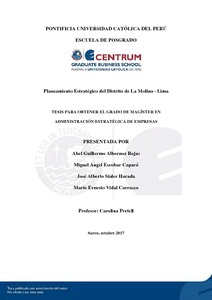| dc.contributor.advisor | Pretell Pardo, Ángela Carolina | |
| dc.contributor.author | Albornoz Rojas, Abel Guillermo | es_ES |
| dc.contributor.author | Escobar Caparó, Miguel Angel | es_ES |
| dc.contributor.author | Sialer Harada, José Alberto | es_ES |
| dc.contributor.author | Vidal Carrasco, Mario Ernesto | es_ES |
| dc.date.accessioned | 2017-11-03T15:03:26Z | |
| dc.date.available | 2017-11-03T15:03:26Z | |
| dc.date.created | 2017 | |
| dc.date.issued | 2017-11-03 | |
| dc.identifier.uri | http://hdl.handle.net/20.500.12404/9631 | |
| dc.description.abstract | El distrito de la Molina creado en 1962 tiene una superficie de 65,75 km2 y cuenta
171,646 habitantes con una densidad poblacional de 2,534 hab/km2. Limita por el norte con
el distrito de Ate Vitarte, por el este con el distrito de Pachacámac y Cieneguilla, por el sur
con los distritos de Pachacámac y Villa María del Triunfo, y por el oeste con el distrito de
Santiago de Surco. Es un distrito predominantemente residencial donde el 64.67% de su suelo
urbano está ocupado por urbanizaciones. El presente plan estratégico para el distrito de La
Molina fue desarrollado con base en el modelo secuencial del proceso estratégico de
D’Alessio (2013) teniendo como proyección el año 2030. Para el desarrollo de este plan se
ha realizado los análisis PESTEC y AMOFHIT. La matriz EFE concluye que La Molina no
está respondiendo bien a las oportunidades y a las amenazas del entorno. Por su parte la
matriz EFI concluye que La Molina no es más fuerte que débil, por lo tanto, debe mejorar sus
debilidades y potenciar sus fortalezas. Asimismo, la visión propuesta busca que La Molina
sea un distrito reconocido por su liderazgo en ecología en el Perú y uno de los cinco mejores
distritos de Sudamérica. Para lograr la visión propuesta se han formulado seis objetivos de
largo plazo, así como 14 estrategias de las cuales se han retenido nueve. Para lograr los
objetivos de largo plazo se ha definido 24 objetivos de corto plazo. Por último, este
documento se enfoca en transformar la situación presente de La Molina con una visión de
crecimiento mejorando el bienestar de sus residentes y visitantes. Esto mediante la
innovación y especialización de la gestión pública apalancada en la inversión pública y
privada | es_ES |
| dc.description.abstract | The district of La Molina was created in 1962, has an area of 65.75 km2 and counts
with 171,646 inhabitants with a population density of 2,534 hab / km2.
It borders on the north with the district of Ate Vitarte, on the east with the district of
Pachacamac and Cieneguilla, on the south with the districts of Pachacámac and Villa Maria
del Triunfo, and on the west with the district of Santiago de Surco. It is predominantly
residential where 64.67% of its urban land is occupied by housing estates.
This strategic plan for the district of La Molina was developed based on the sequential
model of D'Alessio's strategic process in the year of 2013 and projected to be completely
finish by the year 2030. The PESTEC and AMOFHIT analyzes were used for the
development of this plan. The EFE matrix concludes that La Molina is not responding well to
the opportunities and threats of the environment. For its part, the EFI parent concludes that
La Molina is not stronger than weak, therefore, it must improve its weaknesses and turn it in
to oportunities to get even better results at the end.
Likewise, the proposed vision seeks to make La Molina a leading district in ecology
and services in Peru and one of the five best districts in South America. To achieve the
proposed vision, six long-term objectives have been formulated as well as 14 strategies from
which nine have been retained. To achieve the long-term objectives, 24 short-term objectives
have been defined.
Finally, this document focuses on transforming the present situation of La Molina
with a vision of growth to improve the quality of life of its residents and visitors. This
through innovation and specialization of public management leveraged in public and private
investment | es_ES |
| dc.language.iso | spa | es_ES |
| dc.publisher | Pontificia Universidad Católica del Perú | es_ES |
| dc.rights | Atribución-NoComercial-SinDerivadas 2.5 Perú | * |
| dc.rights | info:eu-repo/semantics/openAccess | es_ES |
| dc.rights.uri | http://creativecommons.org/licenses/by-nc-nd/2.5/pe/ | * |
| dc.subject | Planificación regional -- Perú -- Lima | es_ES |
| dc.subject | Desarrollo regional -- Perú -- Lima | es_ES |
| dc.subject | Planificación estratégica | es_ES |
| dc.title | Planeamiento estratégico del Distrito de La Molina - Lima | es_ES |
| dc.type | info:eu-repo/semantics/masterThesis | es_ES |
| thesis.degree.name | Maestro en Administración Estratégica de Empresas | es_ES |
| thesis.degree.level | Maestría | es_ES |
| thesis.degree.grantor | Pontificia Universidad Católica del Perú. CENTRUM | es_ES |
| thesis.degree.discipline | Administración Estratégica de Empresas | es_ES |
| renati.discipline | 413307 | es_ES |
| renati.level | https://purl.org/pe-repo/renati/level#maestro | es_ES |
| renati.type | https://purl.org/pe-repo/renati/type#tesis | es_ES |
| dc.publisher.country | PE | es_ES |
| dc.subject.ocde | https://purl.org/pe-repo/ocde/ford#5.02.04 | es_ES |






